Search Market Research Report
Global Membrane Bioreactor Market Size, Share Global Analysis Report, 2021–2028

Global Membrane Bioreactor Market – By Membrane Type (Multi-Tubular, Flat Sheet, and Hollow Fiber) By System Control (External and Submerged), By Utilization (Industrial Wastewater Treatment and Municipal Wastewater Treatment), and By Region: Global Industry Overview, Market Size, Statistical Research, Market Intelligence, Comprehensive Analysis, Historical Trends, and Forecast 2021–2028
Industry Insights
[201+ Pages Report] According to Facts and Factors, the global membrane bioreactor market was valued at around USD 3.6 billion in 2020 and is expected to increase to about USD 4.9 billion by 2028, with a compound annual growth rate (CAGR) of around 7.2% during the forecast period. The report explores the membrane bioreactor market’s drivers & restraints and the impact they have on the demand during the projection period. In addition, the report analyses emerging opportunities in the membrane bioreactor market.

 Membrane Bioreactor Market: Overview
Membrane Bioreactor Market: Overview
A membrane bioreactor is mainly utilized for the treatment of municipal and industrial wastewater. A semi-permeable or perm-selective membrane method, such as ultrafiltration or microfiltration, is combined with a suspended growth bioreactor. The most popular types of membrane bioreactor systems are vacuum or gravity-driven systems and pressure-driven systems. They keep the floating particles in place and the sediments distinct from the sludge concentrate. They have regulated biomass retention, enhanced effluent quality, a low carbon footprint, and are active against infections.
 Membrane Bioreactor Market: Growth Drivers
Membrane Bioreactor Market: Growth Drivers
The growing use of membrane bioreactors in municipal administrations is driving the global membrane bioreactor market. The tremendous advantages of adopting membrane bioreactors over the traditional activated sludge processes are driving the demand for membrane bioreactors. The growing demand for high-quality treated water and effective pathogen removal from wastewater is increasing the use of membrane bioreactors in industrial and municipal wastewater treatment plants. Increasing R&D activities to create new wastewater treatment methods that use less energy and have lower costs are projected to boost the global membrane bioreactor market over the forecast period.
The global market is anticipated to be driven by the increasing requirement for improving existing wastewater treatment systems that are not reaching their capacity. The use of membrane bioreactors allows the bacterial digestion of waste organic substances as well as the separation of treated effluent from remaining suspended particulates.
Furthermore, favorable government measures pertaining to innovative wastewater treatment procedures are bolstering the global membrane bioreactor market. Membrane bioreactors are quickly becoming the greatest wastewater treatment technology available because they can operate at substantially higher solids content than conventional activated sludge systems.
The use of membrane bioreactors has been driven by severe government rules and regulations regarding the discharge of industrial waste. Concerns about industrial wastewater disposal are increasing the use of membrane bioreactors. Because membrane bioreactors can operate at high sludge concentrations, they are increasingly being used in the industrial sector for the effective treatment of industrial wastes. Membrane bioreactors' lower operational and maintenance costs are encouraging their acceptance in companies and municipalities.
Furthermore, the cost-effectiveness of wastewater treatment methods, aided by government-provided financial aid and incentives, is predicted to promote the industrial sector's use of membrane bioreactors. On the other hand, the significant capital expenditure necessary to establish membrane bioreactors has limited the demand for membrane bioreactors in wastewater treatment.

 Segmentation Analysis
Segmentation Analysis
The global membrane bioreactor market is segmented based on membrane type, system control, utilization, and region.
By membrane type, the market is classified into multi-tubular, flat sheet, and hollow fiber. The hollow fiber category is estimated to account for about 67 percent of the revenue share in 2020, due to its rising acceptance rate in medium-sized municipal and industrial plants due to its light and outstanding reliability in a variety of settings when compared to others.
By system control, the global membrane bioreactor market is divided into external and submerged. The submerged membrane bioreactors category is expected to grow at a 10 percent CAGR during the forecast period, owing to factors such as considerable energy savings from using coarse bubble aeration.
By utilization, the market is classified into industrial wastewater treatment and municipal wastewater treatment. The municipal segment contributed 84.1 percent of the revenue share in 2020, owing to a rising need for improved public infrastructure, expanding urban population, and increasingly severe waste management standards and regulations.
 Report Scope
Report Scope
Report Attribute |
Details |
Market Size in 2020 |
USD 3.6 Billion |
Projected Market Size in 2028 |
USD 4.9 Billion |
CAGR Growth Rate |
7.2% CAGR |
Base Year |
2020 |
Forecast Years |
2021-2028 |
Key Market Players |
Suez Environnement S.A., General Electric Energy LLC, Mitsubishi Chemical Corporation, Danaher Corporation, Toray Industries, Calgon Carbon Corporation, Kubota Corporation, Aquatech International Corporation, Buckman Laboratories, CITIC Envirotech Ltd, Veolia Environnement S.A., B&P Water Technologies s.r.l., MANN+HUMMEL Water & Fluid Solutions, and Culligan International Company. |
Key Segment |
By Membrane Type, By System Control, By Utilization, and By Region |
Major Regions Covered |
North America, Europe, Asia Pacific, Latin America, and the Middle East & Africa |
Purchase Options |
Request customized purchase options to meet your research needs. Explore purchase options |
 Regional Landscape
Regional Landscape
The Asia Pacific dominated the global membrane bioreactor market, accounting for 45 percent of the global revenue in 2020. Domestic housing sector expansion in Southeast Asian countries is expected to be boosted by higher disposable income and urban population growth. As a result, the rising housing sector is expected to increase the penetration of municipal wastewater facilities for urban populations, hence driving demand for membrane bioreactors over the projection period.
The use of wastewater treatment equipment will increase in the coming years as China`s crude oil production increases as a result of favorable government policies encouraging domestic investment and increasing applications in the polymer industry. Favorable prospects for China's mining sector due to the number of limited earth minerals are expected to have a significant role in accelerating the growth of the membrane bioreactor market by expanding the utilization of landfill sludge treatment.
The membrane bioreactor market in the Middle East and Africa is expected to grow at a CAGR of 13 percent during the forecast period, due to population growth, sustainable growth, and industrialization in the region. The Middle Eastern governments, especially Saudi Arabia and the United Arab Emirates, have increased spending on the construction of refining and petrochemical facilities, thereby raising the demand for membrane bioreactors.
The membrane bioreactor market is likely to be driven by Saudi Arabia's increasing demand for potable water. Furthermore, advancements in disinfection technology, combined with cheap equipment costs, are projected to propel the market. Furthermore, high-level toxicity in municipal water is projected to drive membrane bioreactor demand over the projection period.
 Recent Development
Recent Development
- In August 2021, Kubota Membrane USA Corporation, a Kubota family company that supplies membrane bioreactor systems to industrial and municipal customers, has signed an agreement to supply MBR systems and ancillary equipment to the 32MGD Big Creek Water Reclamation Facility in Fulton County.
 Competitive Landscape
Competitive Landscape
Due to the existence of both global and local players, the global membrane bioreactor market is extremely competitive. To increase market penetration and fulfill changing technical demand from diverse application sectors such as industrial and municipal areas, membrane bioreactor manufacturers use a variety of tactics such as acquisitions, partnerships, new product development, and regional growth.
Some of the leading players in the global membrane bioreactor market include :
- Suez Environnement S.A.
- General Electric Energy LLC
- Mitsubishi Chemical Corporation
- Danaher Corporation
- Toray Industries
- Calgon Carbon Corporation
- Kubota Corporation
- Aquatech International Corporation
- Buckman Laboratories
- CITIC Envirotech Ltd
- Veolia Environnement S.A.
- B&P Water Technologies s.r.l.
- MANN+HUMMEL Water & Fluid Solutions
- Culligan International Company
The global membrane bioreactor market is segmented as follows:
 By Membrane Type Segment Analysis
By Membrane Type Segment Analysis
- Multi-Tubular
- Flat Sheet
- Hollow Fiber
 By System Control Segment Analysis
By System Control Segment Analysis
- External
- Submerged
 By Utilization Segment Analysis
By Utilization Segment Analysis
- Industrial Wastewater treatment
- Municipal Wastewater Treatment
 By Regional Segment Analysis
By Regional Segment Analysis
- North America
- The U.S.
- Canada
- Mexico
- Rest of North America
- Europe
- France
- The UK
- Spain
- Germany
- Italy
- Nordic countries
- Denmark
- Finland
- Iceland
- Sweden
- Norway
- Benelux Reunion
- Belgium
- The Netherlands
- Luxembourg
- Rest of Europe
- Asia Pacific
- China
- Japan
- India
- New Zealand
- Australia
- South Korea
- Southeast Asia
- Indonesia
- Thailand
- Malaysia
- Singapore
- Rest of Southeast Asia
- Rest of Southeast Asia
- The Middle East & Africa
- Saudi Arabia
- UAE
- Egypt
- Kuwait
- South Africa
- Rest of the Middle East & Africa
- Latin America
- Brazil
- Argentina
- Rest of Latin America
Industry Major Market Players
- Suez Environnement S.A.
- General Electric Energy LLC
- Mitsubishi Chemical Corporation
- Danaher Corporation
- Toray Industries
- Calgon Carbon Corporation
- Kubota Corporation
- Aquatech International Corporation
- Buckman Laboratories
- CITIC Envirotech Ltd
- Veolia Environnement S.A.
- B&P Water Technologies s.r.l.
- MANN+HUMMEL Water & Fluid Solutions
- Culligan International Company
Frequently Asked Questions

Copyright © 2025 - 2026, All Rights Reserved, Facts and Factors


